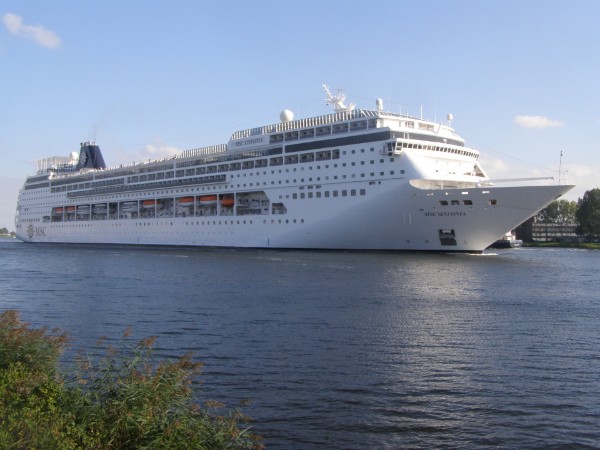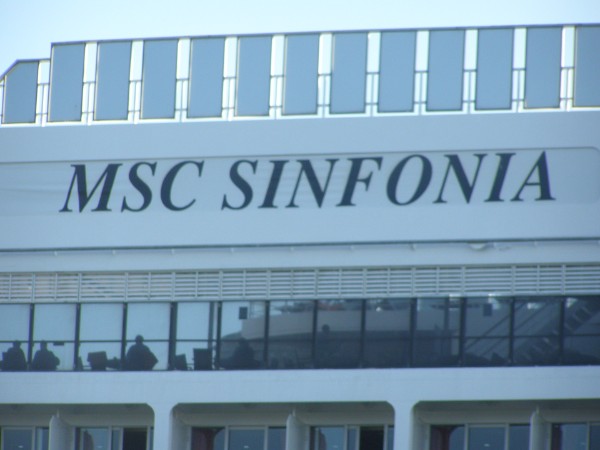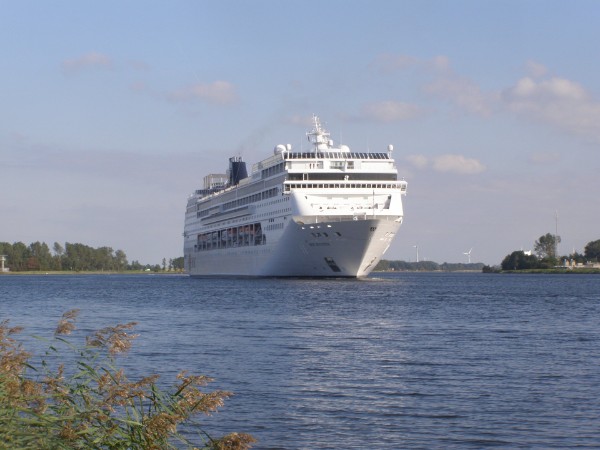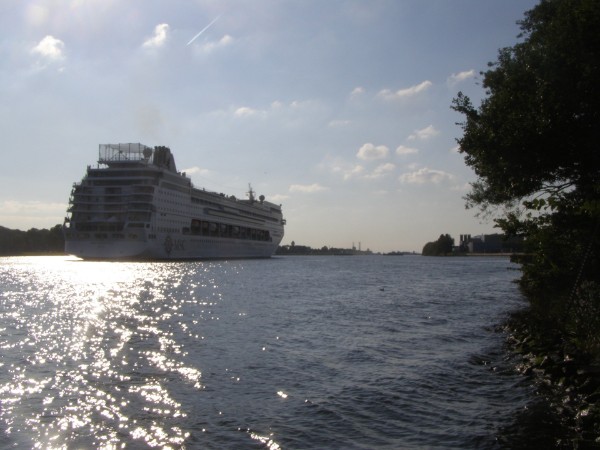MSC Sinfonia
At the end of the last century, Festival Cruises was looking to enlarge the fleet with modern liners. They were sailing with several older cruiseships throughout the 1990's, but with more modern passengerliners exploring the European waters, including the large American lines, the European companies themselves had also to invest. So when the company Services et Transport from France, also the owner of Club Med Cruises, ordered a new 47.000-ton ship but were unable to finish her, Festival took over the contract and had her finished as their Mistral in 1999. This was the first modern ship in the fleet of Festival and immidiately, the company placed an order for similar but still larger ships. Two ships became a firm order and the option was also taken for two more. The first ship of this class, in comparissement to Mistral they measured close to 60.000 ton, was launched in december 2000 as European Vision. The ship was about to start a new naming strategy for Festival Cruises, making clear its European base as a Greek company dedicated to the European market. The second ship was floated out at the 24th of march 2001 and was named European Dream. It was a change in name, as she was originally planned to be named European Stars.
Below, MSC Sinfonia shows herself sailing past the village of Velsen-Noord between Amsterdam and the sea at the 9th of september 2015. It was just after her first visit to The Netherlands.

Festival Cruises chartered out two of their older ships, Bolero and Flamenco, to other lines but financially, the company was very unstable. They had tried to merge with P&O in the end of the 1990's but because the shares of Festival were so low, the deal collapsed. So Festival had to pay for the enlargement on their own account and this caused the company to cancel the option for two more ships. Cleverly, MSC Cruises, another company sailing with several older ships in the Mediterranean stepped in and took over the contract so they were also able to built two modern liners. But MSC was backed by the worlds largest privately owned shippingcompany and were financially sound.
Then, there came another problem, still during the buildingprocess of the European Dream. At the 11th of september of 2001, terrorism shocked the world when four passengerplanes were hijacked in the USA. Two planes were flown into two of the worlds largest buildings, the New York WTC, one was crashed into the Pentagon in Washington and one crashed in a cornfield because the passengers tried to take over the plane again. In total, over 3500 people lost their lives that day and the American president Bush declared war on internaional terrorism. Of course this also was a devastating blow to tourism worldwide, especially to the Mediterranean as the focus of this new war was on the Middle East, from where the terror came. For Festival, business was focussed also on the Mediterranean and with their financial problems already, future seemed bleek.

But of course, they could do little else then finish the ship and at the 18th of april of 2002, European Dream was delivered to the company. She measured 58.625 tons, had a lenght of 251,20 meters, was 28,80 meters wide and her draft measured 6,80 meters. The ship had been built at the Chantiers L'atlantique wharf at St.-Nazaire, France under yardnumber X31. She was to carry 1566 passengers in 783 cabins and 763 crewmembers. European Dream was powered by two gasturbines, two generators and two electric motors designed by General Electric Marine, that were giving the ship a speed of 21 knots. Of course, the ship was propelled by the modern find of pods instead of the traditional propeller. Her homeport was to be Genoa, Italy and the ship was named at St.-Nazaire at the 19th of april of 2002. Based on the Mistral blueprint, the ships were enlarged with a 35-meter midsecion and an additional deck with balcony cabins.
Her first cruise departed Barcelona at the following 25th of april in the western Mediterranean, which was the main cruiseregion for Festival Cruises. But she only was able to cruise here untill january the 19th, 2003 as Festival Cruises was unable to pay its debts and the ships of the line had to be laid-up. Several months later, the line was declared bankrupt and all operations ceased. The ship was furthermore laid-up at Marseilles already, awaiting a buyer. Although she was a modern liner the askingprice of 220 million US dollars was a little of a gamble in the world as it was right then, because of the uncertaincy. There were rumours that a thirth worldwar was to start when the war on terror would spread to other parts of the world and in fact, I think that there actually started one indeed, just a total different war then the first and second. You can imagine that cruiselines, sailing in many parts of the world, were severely hit in those years and orders and sales plummited. But there was one company eager to get more modern ships into their fleet that had also still the financials to do so. MSC Cruises had already brought into service the slightly altered sisterships of the Festival pair as MSC Lirica in april of 2003 and MSC Opera in june of 2004. That they were the company to pick up the two other ships was not a total surprise and in april of 2004 they actually had bought the European Vision, brought into service as MSC Armonia and in july they also bought the European Dream that entered service again as their MSC Sinfonia. As you can see in the names, the company followed a theme in music and because the MSC Lirica had been the first ship that had entered service for MSC, the class of four was now referred to as the Lirica class.

For MSC, The ship was rebuilt slightly, although the style of Festival Cruises wasn't that different from that of MSC. Both companies sailed the same waters in European style, mostly Italian. The ships interiours were classy, modern and very light with cream and lightbrown colouring, The ships of MSC and Festival before had always been also very popular with Americans as they offer a totally different style then the American-orientated main lines sailing from Florida as not every American seems to adore neons, bright shiny floors and funpark-style. MSC Sinfonia was now registered at Panama and she started cruising for MSC in march of 2005.
For MSC Cruises, the addition of these four modern ships were the first indication of a growth we do not see often in the cruise-indusrty. of course backed by huge financials, the company was able to invest. With over 500 ships sailing worldwide, MSC as a whole is mostly concentrating on containerized goods and the company is still family owned so the lines are short. Also the freightpart has been growing in a staggering rate, by the way. When the company bought the Lauro Line in 1987 and entered the world of cruising, it did not seem to be a focus at that moment. They even were not using the name MSC for the cruisepart in the first years, starting with that just in 1995 after many problems under the Lauro name. Before the year 2003, when the MSC Lirica entered service, the company only sailed with just a few older cruiseships, mostly in the Mediterranean and they seemed to be just a marginal part of the industry. But the introduction of those four modern ships tasted for more and the MSC management started to change and invest rapidly in the cruisedivision. The company immidiately ordered a class of four 90.000-ton ships that entered service between 2006 and 2010 as the Musica class. Next to that, another class of ship was ordered just in the same decade still and this was the largest class of passengerships ever ordered by a European company untill then, the 133.000 ton Fantasia class of four ships, entering service between 2008 and 2013. So the company added a staggering 12 modern liners in ten years, growing into a company that had to be recognized with the main players. As those ships had entered service, MSC announced the building of two additional classes of megaships, One class of 167,000 ton ships, that will be the thirth largest class of passengerships in history and one class of 154.000 ton ships. With those, MSC will again double it's capacity in the next decade. Next to all those newbuilds, in 2014 it was announced that the Lirica class of ships would be enlarged and modernized. In this so-called Renaissance program, all ships would recieve a new midsection and a total overhaul.

At the 20th of january 2015, MSC Sinfonia was drydocked for ten weeks at the Fincantieri Yards at Palermo, Italy for the insertion of a 24-meter midsection. In this, 193 extra cabins were added to the ship. When she emerged again, the ship had a new tonnage measurement of 65.542. She now is 274,90 meters long, 32 meters wide and her passengercapacity now is 2679. Also the crewnumber had grown to 721.

